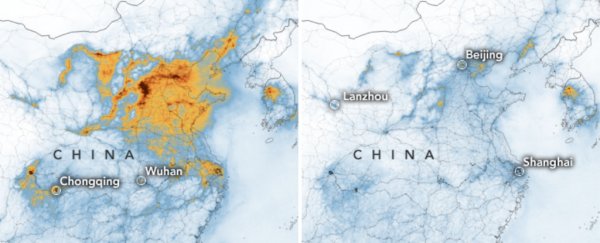The COVID-19 coronavirus outbreak has caused widespread alarm, travel bans, and the quarantine of multiple cities across the world.
But there's also been an unexpected effect on the environment, in the form of a notable drop in nitrogen dioxide emissions levels across China.
Data collected from the Tropospheric Monitoring Instrument (TROPOMI) on ESA's Sentinel-5 satellite shows a significant drop of nitrogen dioxide – a gas mainly emitted by cars, trucks, power plants and some industrial plants - between January 1 and February 25.
"This is the first time I have seen such a dramatic drop-off over such a wide area for a specific event," said Fei Liu, an air quality researcher at NASA's Goddard Space Flight Centre.
Although during the end of January and start of February there is usually a drop in nitrogen dioxide across China as businesses close during the Lunar New Year, this year, the reductions have continued long after the end of the festival.
 (Joshua Stevens/Copernicus Sentinel 5P/ESA)
(Joshua Stevens/Copernicus Sentinel 5P/ESA)
A sensor on NASA's Aura satellite – Ozone Monitoring Instrument (OMI) is also making measurements on the drop in pollutants.
"There is always this general slowdown around this time of the year," said Barry Lefer, an air quality scientist at NASA. "Our long-term OMI data allows us to see if these amounts are abnormal and why."
Satellite data isn't the only way we're seeing a drop in China's emissions.
An early analysis published by Carbon Brief in February showed that coal use at power stations is at a four year low, and domestic flights are down 70 percent. Along with a drop in steel manufacturing and oil refinery output, they estimate this might have lowered the country's carbon dioxide emissions by approximately a quarter over the last few weeks.
However, just because industries have lowered their carbon dioxide output and nitrogen dioxide levels are lower above China, it doesn't mean that the air is cleaner in the cities. In mid-February Beijing's air pollution levels were still 10 times the recommended level by the World Health Organisation.
"Even without car emissions, these industrial and coal-fired emissions are enough to plunge Beijing into consecutive days of severe pollution amid unfavourable weather," Ma Jun, director of the Institute of Public and Environmental Affairs, told South China Morning Post.
"The priority now is to continue strengthening the regulation of industry and the burning of coal."
It's important to note this isn't the first time we've seen dramatic drops in China's air pollution levels. In 2008, during the Beijing Olympic Games, there was a huge drop of nitrogen dioxide above the city, but pollution levels rose again soon after the Olympics ended.
 (Joshua Stevens/Copernicus Sentinel 5P/ESA)
(Joshua Stevens/Copernicus Sentinel 5P/ESA)
Finally, the researchers note that the overall values of nitrogen dioxide are lower this year than last year as China has begun enforcing stricter environmental regulations, as you can see in the satellite images of Wuhan above.
But none of these factors themselves add up to such a strong reduction in nitrogen dioxide - meaning it's likely at least partially caused by the coronavirus outbreak.
"This year, the reduction rate is more significant than in past years and it has lasted longer," Liu said.
"I am not surprised because many cities nationwide have taken measures to minimise [the] spread of the virus."
